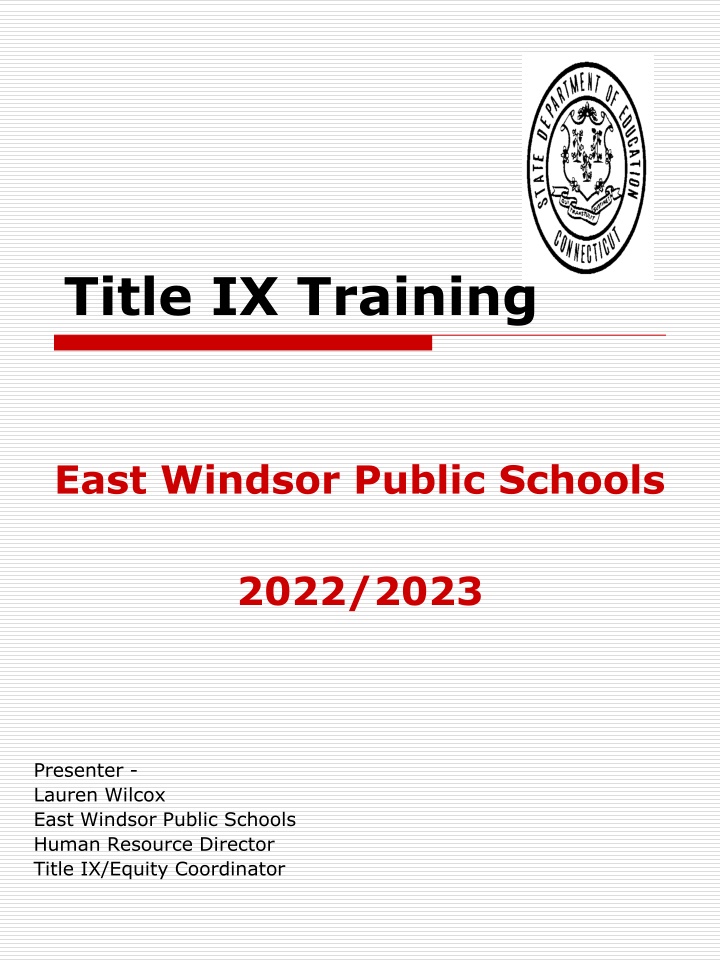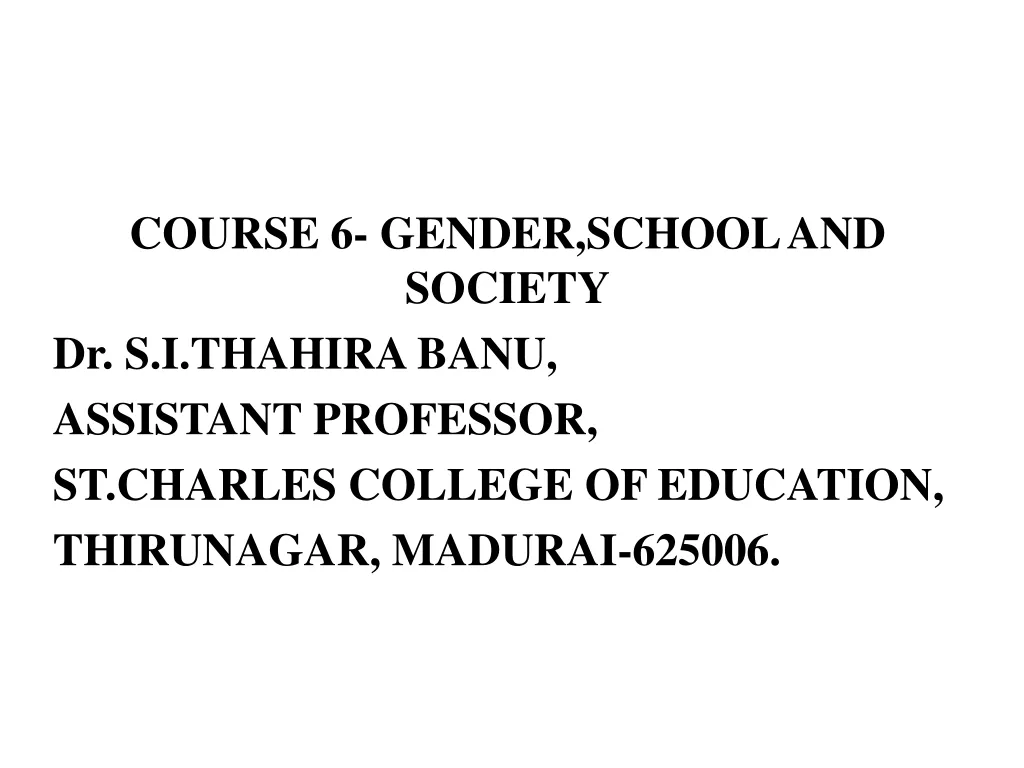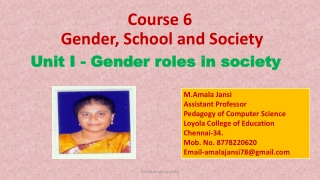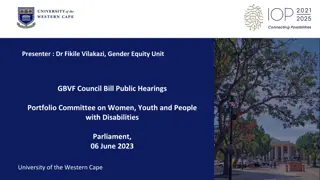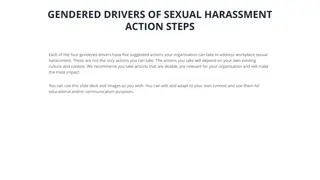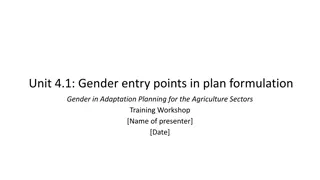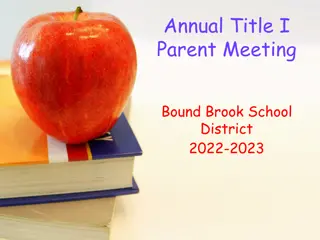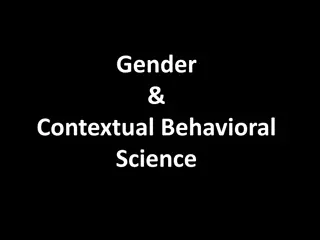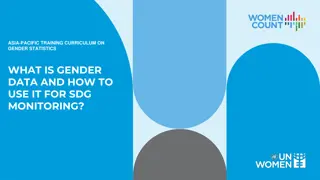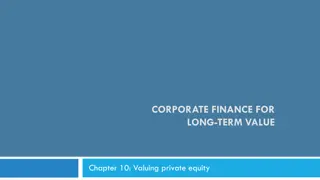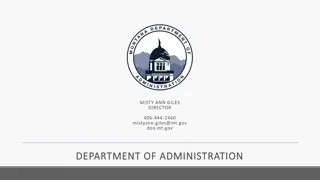Title IX Training and Gender Equity in Education
This content covers Title IX training, Connecticut laws on education, gender equity, examples of discrimination, and protected classes in education. It emphasizes equal opportunities in public schools regardless of gender, race, or other characteristics.
Download Presentation

Please find below an Image/Link to download the presentation.
The content on the website is provided AS IS for your information and personal use only. It may not be sold, licensed, or shared on other websites without obtaining consent from the author.If you encounter any issues during the download, it is possible that the publisher has removed the file from their server.
You are allowed to download the files provided on this website for personal or commercial use, subject to the condition that they are used lawfully. All files are the property of their respective owners.
The content on the website is provided AS IS for your information and personal use only. It may not be sold, licensed, or shared on other websites without obtaining consent from the author.
E N D
Presentation Transcript
Title IX Training East Windsor Public Schools 2022/2023 Presenter - Lauren Wilcox East Windsor Public Schools Human Resource Director Title IX/Equity Coordinator
Title IX Title IX of the Education Amendments of 1972 (20 U.S.C. 1681 et seq.) prohibits sex discrimination in education programs and activities. "No person in the United States shall, on the basis of sex, be excluded from participation in, be denied the benefits of, or be subjected to discrimination under any education program or activity receiving Federal financial assistance." 2
Connecticut Law Sec. 10-15c The public schools shall be open to all children five years of age and over . . . and each such child shall have, and shall be so advised by the appropriate school authorities, an equal opportunity to participate in the activities, programs and courses of study offered in such public schools . . . without discrimination on account of race, color, sex, religion, national origin, or sexual orientation. 3
Connecticut Education Protected Classes race color religious creed sex age national origin ancestry marital status sexual orientation mental retardation physical disability or learning disability, or any other basis prohibited by Connecticut or federal law 4
Gender Equity is: An equal chance for learning for female and males Equitable options to learn subjects and prepare for future education, jobs and careers No limits on expectations due to gender Equal encouragement for both females and males to develop achieve and learn Equitable treatment of male and female students 5
Examples Of Intentional Discrimination? 1. Guidance counselors consistently tell male students about opportunities to take engineering classes, but fail to mention those opportunities to female students. 2. Teachers consistently call on boys more than girls. 3. Recruitment materials feature only girls in child care classes. 4. A principal refuses to promote a woman to assistant principal because he believes she will soon get pregnant and leave. 6
Equal Benefits/Services Boys and girls athletics programs must be equal overall,* including: Scheduling Travel Coaching Locker rooms/facilities Medical/training services Publicity Recruiting Tutoring Housing/dining * No booster club exception 8
Title IX: Pregnancy BASIC RULES Schools may not discriminate (in academic or extracurricular activities) based on pregnancy, childbirth, false pregnancy, termination of pregnancy, or recovery from any of these conditions. Schools must treat students affected by pregnancy and related medical conditions the same as students similarly affected by temporary disabilities. 9
Recommendations Ensure compliance with Title IX (school climate) Excused absences for illness or medical appt. of student s child Flexibility in scheduling Goal-setting and guidance, encouragement Individualized graduation plans Home instruction during maternity leave Child care, transportation assistance Secondary pregnancy prevention Access to social services and health care Parenting classes teaching range of life skills Outreach to dropouts 10
What Is Retaliation? Any form of adverse treatment, which for students can include: Suspension or expulsion Reduction in grades Denial of permission to participate on teams, or change in position on team, amount of playing time, etc. Harassment in class or on the field 11
What Is Retaliation? Any form of adverse treatment, which for employees can include: Demotion or termination Reduction in pay Material change in job duties Harassment on the job Refusal to give positive job references 12
Stipulations 1. School systems or other recipients of federal funds must designate at least one employee as the Title IX coordinator to oversee compliance efforts and investigate any complaints of sex discrimination. Although at least one employee is required to be designated to coordinate compliance with Title IX, it is the shared responsibility of the entire school district, from top-level administration to individual staff, to foster compliance. 13
Stipulations 2. All students and employees must be notified of the names, office address(es), and telephone number(s) of the designated coordinator(s) of Title IX. 3. Grievance procedures and nondiscrimination policies must be made public. 14
Harassment Is Discrimination Harassment includes: Sexual harassment Gender-based harassment (name calling, stereotyped remarks) 15
Sexual Harassment Title IX requires schools to have an anti- discrimination policy and grievance process to address sex discrimination, including sexual harassment. Legal obligation to take steps to prevent harassment and address any harassment that occurs Need to step in before conduct amounts to unlawful harassment. 16
Sexual Harassment Is: Conduct of a sexual nature; That is unwanted and unwelcome; and That interferes with a student s right to learn, study, work, achieve, or participate in school activities in a comfortable and supportive atmosphere. 17
Two Types of Sexual Harassment: Quid Pro Quo: Benefits (or penalties) are conditioned on an individual s submission to (or failure to submit to) requests for sexual favors Hostile Environment: Harassment that does not result in a tangible benefit or penalty, but that is sufficiently severe or pervasive to limit the victim s ability to participate in classes, activities, or other aspects of the educational program. 18
Harassment Can Be: Perpetrated by a teacher, student or third party Directed by either gender at the other Directed at a victim of the same gender as the harasser, as long as the harassment is based on sex, not sexual orientation 19
Harassment Can Take Place: In classrooms In hallways On school grounds On school buses On field trips At sporting events At teachers offices or homes Off campus; anywhere 20
Harassment Can Cause: Physical or emotional injury to victims Disruption of education Damage to a school s reputation Legal liability for a school 21
Examples of Hostile Environment Harassment Physical Conduct Unwelcome sexual advances Unwanted hugs, touches or kisses Other physical conduct of a sexual nature Non-Physical Conduct Suggestive or lewd remarks or jokes Derogatory or pornographic posters, cartoons, screen savers 22
How Can You Tell If Advances Are Unwelcome ? Put yourself in the position of the alleged harasser and ask: Would you want your behavior to appear on the evening news? Is there a difference in status or power between you two? Would you behave the same way if a family member were standing next to you? Would you want someone else to act this way toward your spouse or significant other? 23
Sexual Harassment Board of Education Policy 5145.5 Students The East Windsor Board of Education is committed to safeguarding the right of all students within the school district to a school environment that is free from all forms of sexual harassment. Sexual harassment does not only depend upon the offender s intention but also upon how the student perceives the behavior or is affected by it. The Board recognizes that sexual harassment can originate from a student of either sex against a student of the opposite or same sex, and from adults and/or school district employees. Sexual harassment will not be tolerated among students of the school district. It is the policy of the Board of Education that any form of sexual harassment is forbidden whether by students, supervisory or non-supervisory personnel, individuals under contract, or volunteers subject to the control of the Board. Students are expected to adhere to a standard of conduct that is respectful and courteous to employees, to fellow students and to the public. Therefore, the Board condemns all unwelcome behavior of a sexual nature which is either designed to extort sexual favors from a student, or which has the purpose or effect of creating an intimidating, hostile, or offensive school environment. The Board also strongly opposes any retaliatory behavior against complainants or any witnesses. 24
What Should You Do If Harassment Occurs? Don t Wait For A Complaint Need to address harassment whenever you become aware of it, whether or not a formal complaint is filed 25
What Should You Do If Harassment Occurs? Stop Any Ongoing Harassment Immediately. Moving quickly tells everyone that such behavior is not acceptable and that your school takes harassment seriously. You also must take steps necessary to ensure that the harassment does not recur. 26
What Should You Do If Harassment Occurs? Investigate All Allegations of Harassment. Immediate and appropriate steps to investigate and determine what occurred, regardless of whether formal complaint filed. The inquiry must be prompt, thorough, and impartial. At a minimum, investigation should include interviews with victim, alleged harasser, and anyone else who may have relevant information. Keep complete records of investigations, including detailed description of victim s allegations, notes on all interviews, the outcome of the investigation, and any action taken by your school. 27
Dangerous Words When responding to a complaint, be careful that these words don t come out of your mouth: It s just teasing- no big deal. The people in our school would never do I know he/she didn t mean anything like that. It s your fault for dressing so provocatively. You need to learn to handle these things. 28
Dangerous Words Just ignore it. He puts his arms around everyone. Why can t you learn to accept a compliment? You must have wanted it- otherwise you would have told him no. That s how they do things where he comes from. It s a joke. Lighten up. No one s filed a charge so our hands are tied. 29
Dangerous Words We ve never had a complaint, so we don t have a problem. This kind of behavior is all a part of growing up. It s a matter of hormones, we can t control that. If we had to discipline every student who used bad language we d never get anything else done. Its just a prank that got out of hand. Oh well, boys will be boys. 30
What Is Effective and Appropriate Remedial Action? Steps to eliminate the effects of the harassment by addressing the victim s injuries: Removing negative grades or evaluations that resulted from the harassment from the student s record Allowing student to retake a test or class in which s/he has performed poorly Damages to compensate for out of pocket costs and emotional distress 31
Additional Strategies Teachers: Act quickly when confronted with sexual harassment. Ensure that you report any instances of harassment of which you are aware to the person designated by the school to handle such complaints. Strategize with students about improving the classroom environment. Enlist the support of parents. Make certain the classroom is a welcoming environment for all students. 32
